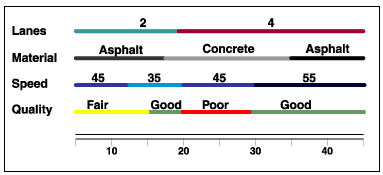Roadway Centerline
Former user (Deleted)
The DDOT Centerline
We maintain centerline-based roadway data for all roads and alleys open to traffic within the District of Columbia. DDOT uses a linear referencing system (or LRS) to maintain both the centerline/road GIS as well as the various attributes and characteristics about that roadway. There are 3 major components of our LRS-based centerline GIS:
Why Linear Referencing?
In a Linear Referencing System (or LRS), centerline "routes" are the geographic representation of a roadway. DDOT uses route centerlines for maintaining linearly referenced data about the roadway. This means that most characteristics about the roadway (number of lanes, surface type, median type present, etc) are stored in related tables with a reference (using the RouteID) to a given route. DDOT and most transportation agencies avoid adding these characteristics as direct table attributes on centerline.
The power of linear references allows us to keep the centerline isolated from any attribute changes. Why is this important? In typical GIS editing, a change in any attribute for a feature will require the user to split the feature where the change begins (think of when a road goes from 2 lanes to 4 lanes). Imagine how many segment breaks we would have if Lanes, Material, Speed and Quality were all attributes maintained on a centerline feature class.
In the graphic below, there are several changes which take place along the roadway. Linear referencing allows us to store the attributes in separate tables leaving us free to change/update the data about the roadway- without breaking the centerline every time a change is needed. Pretty cool, eh? ![]()

From ESRI's What is Linear Referencing?.
Making LRS Data More Accessible (and Usable)
While LRS is a powerful way to store information about our roadway network, it has traditionally be extremely difficult for other users to actually harness this power. With this in mind, DDOT's GIS team has authored a number of Python-based tools to transform the data into much more usable formats.
The below sections describe the steps to get to those more usable formats.
LRS Core Data Elements
DDOT's LRS is a platform that manages 3 basic components. Functionally, these represent the 'skeleton' of the roadway network:
- Routes (unbroken centerline)
- /wiki/spaces/GIS0225/pages/2053603517
- Data about the roadway. (characteristics like number of lanes, speed limit, etc)
Segmentation Data Elements
From these 3 LRS Base Data Elements, we use Python scripting to "chop up" or segment these base data elements in a variety of ways. Segmenting the roadway in such a way helps us to build some of the centerline data products you might be more familiar with.
- Subblock Segments
- Block Segments
- Block/Subblock Intersections
- Intersection Approach Segments
- Blockface Segments
How We Update the Centerline and Other Data
- Construction updates from DDOT projects and infrastructure team
- Notifications from the public/other agencies, like OCTO's Master Address Repository team and even the public
The Old Centerline Management System(s)
We have transitioned to a modern centerline maintenance platform called Roads and Highways (an ESRI extension to the ArcGIS platform). Although this change comes with a lot of exciting new features and capabilities, one of the downsides is that we will no longer maintain certain legacy data. Below are a listing of items which are now managed differently or are no longer be maintained by DDOT after :
| If you currently use... | We recommend changing to... |
|---|---|
| Street Segments | Blocks |
| Roadway Segments | SubBlocks |
| Street Codes | Unfortunately, the Street Code table will no longer maintained by DDOT. Moving forward, we recommend you utilize the 'RouteID' field, which is found in our centerline Routes table. This will provide an equivalent, persistent and unique ID for a given roadway. |
History
In the years since it's inception, the simple centerline has changed quite a lot. Read a bit more about the origins of the DDOT centerline: from paper-based engineering drawings and ROW cards in the DC Office of the Survey all the way to our modern-day LRS. We've come a long way and it's interesting to understand where we've been. Visit the DDOT Centerline Legacy page for more.